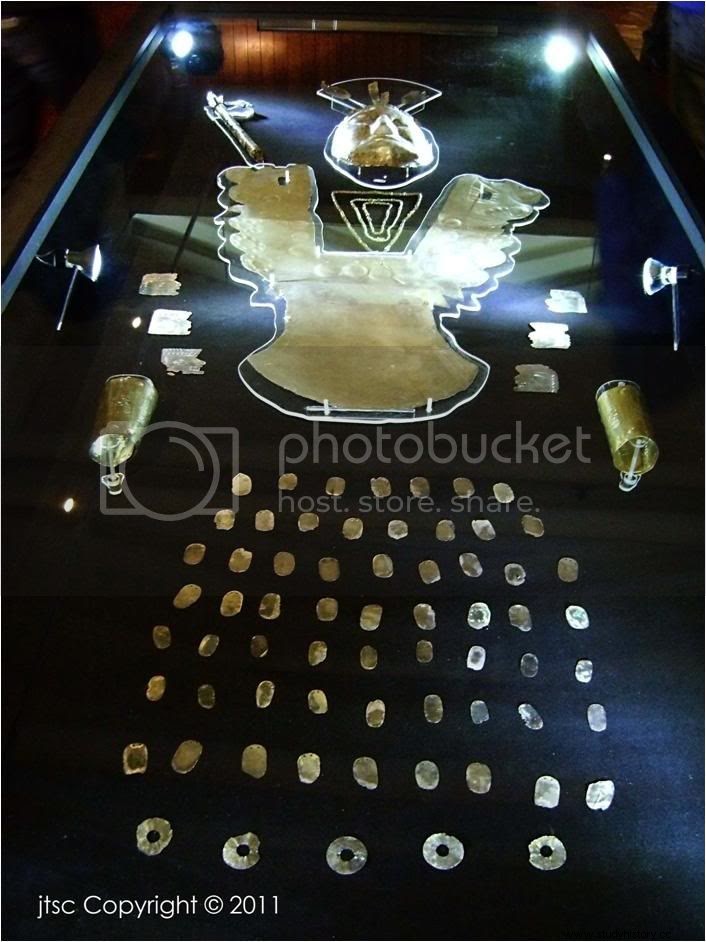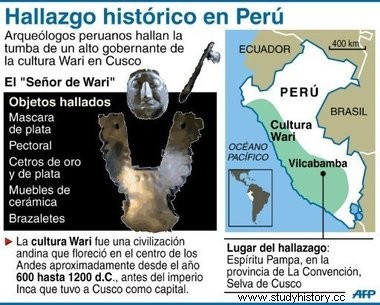
Among these tombs, found in the jungle area of the department of Cusco -ancient capital of the Inca empire -, the remains of a noble character stand out, adorned with pieces of gold and silver, baptized as the Lord of Wari.
"It is an impressive Wari find in the middle of the Cusco jungle that opens a new chapter in archaeological investigations and forces us to write history again," said Juan García, regional director of culture for Cusco, on Wednesday night, when announcing the discovery. "The discovery is one of the most important and comparable to Machu Picchu, the Inca fortress that is Peru's top tourist attraction, and the Lord of Sipán," discovered in northern Peru in 1987, belonging to the Moche culture, he added. The complex It was discovered in the archaeological citadel of Espiritu Pampa, in the Amazonian province of La Convención, district of Vilcabamba, in Cusco (1,100 kilometers southeast of Lima). In the tomb of the Lord of Wari, a silver pectoral in the shape of a 'Y', a mask -also silver- with an anthropomorphic figure, along with two gold bracelets showing feline figures, two chonta (jungle wood) staffs lined with silver sheets, in addition to other pieces.
 Archaeologist Luis Lumbreras, former director of the National Institute of Culture, told AFP that it is a discovery "Spectacular, truly amazing." "This will allow us to review part of the Inca history," he said, explaining that the idea was that the jungle area of Espiritu Pampa in Vilcabamba was considered the last refuge of the Incas against the Spanish. "But this is not the case, because the area was already known long before by the Wari," he specified.
Archaeologist Luis Lumbreras, former director of the National Institute of Culture, told AFP that it is a discovery "Spectacular, truly amazing." "This will allow us to review part of the Inca history," he said, explaining that the idea was that the jungle area of Espiritu Pampa in Vilcabamba was considered the last refuge of the Incas against the Spanish. "But this is not the case, because the area was already known long before by the Wari," he specified.He noted that until now no one in Peru had found a trace of the Wari in the jungle, especially a funeral home that housed the tomb of "a dignitary bordered by a precious mask that looks a bit like the Tutankhamun-type mask in Egypt."
Lumbreras asserted that after this discovery it would not surprise him that there is a Wari citadel "which perhaps would have something to do with legends and fables such as that of Paititi". According to an ancient legend, Paititi is a lost city somewhere in the jungle, rich in gold, which many Spanish explorers searched for without success in the jungles of Peru, Bolivia and Brazil.
The Minister of Culture, Juan Ossio , said that based on this discovery, a series of questions now arise about the expansion of this civilization and about its relations with the Inca empire. He stressed that the Incas and the Wari "are the two great expressions of the State of pre-Hispanic Peru."

The first signs of this discovery were found last July, when pots and other objects were found. Three months later, the nine tombs were found, determining that they corresponded to the Wari culture.
Going back to the Lord of Vilcabamba, its importance forces us to reconsider the relationship between Cusco and Ayacucho in the pre-Columbian era. The first empire would have been very present, both in the heart and in the provinces of Cusco. The Wari city of Pikillacta, just a few kilometers from today's Cusco, and this Lord who is also a Wari, point to an Ayacucho domain of the area.
Perhaps Cusco became great by defeating its former sovereigns from Ayacucho. The Inca Pachacútec would have culminated a long historical cycle of confrontations, achieving the final subjugation of the Chancas, the last exponents of the old Wari state tradition.
